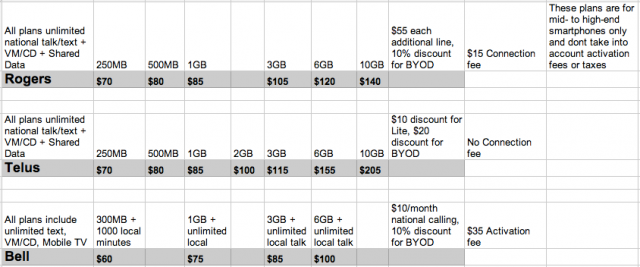 This is by no means a conclusive chart, but the above roughly outlines what a single user will be paying for a new high-end smartphone on a two-year contract on each of the incumbents. Because we’re using leaked data for the Rogers numbers, this is subject to change on August 9th (or sooner).
This is by no means a conclusive chart, but the above roughly outlines what a single user will be paying for a new high-end smartphone on a two-year contract on each of the incumbents. Because we’re using leaked data for the Rogers numbers, this is subject to change on August 9th (or sooner).
What you can see is that, yes, prices are generally going up for the average user. One must take into account that the subsidy of a new phone will be paid off after 24 months instead of 36 on the former plans, and there are no longer any cancellation fees associated with ending your service once those 24 months are finished.
Bell also has the advantage of being a little more flexible (and parsimonious) with its plan fees, giving users the option of adding national calling for $10/month on top of the initial price, but comes out cheaper overall.
TELUS is the only one of the three carriers to actually discount nearly the entire cost of a non-subsidized smartphone (if the subsidy is $500) by discounting $20 per month (or $480+tax over two years) for those wanting to bring their own devices. Rogers and Bell, on the other hand, discount a meagre 10% per month, which works out to a maximum of $14 for the 10GB plan on Rogers and $10 for the 6GB plan on Bell.
Rogers and TELUS are going all-in on nationwide unlimited talk and text, differentiating only by data pool. Bell is almost working with the same canvas — 1000 local minutes is more than enough for most users in the cheapest Data Plus plan — but, as stated, charges $10/month extra for unlimited nationwide talk. Thankfully, all three carriers now include basic services like voicemail and call display, though only the lowest tier as far as I can tell (three voicemails saved for three days max).
Despite TELUS’ clear-and-simple approach to separating basic voice and text from shared data pools, it is by far the most expensive when the account is used by only one person. Rogers appears to have set a $55 flat fee for any extra smartphone added to the shared data pool, whereas TELUS is a little more flexible, giving BYOD users the option of being added to an existing data pool for $35, an entry-level smartphone on a two-year term for $45, and a high-end device for $55.
Indeed, Bell is the only one of the three carriers not to significantly raise base prices across the board, but it is also the only one without a clear data-sharing option, which means that multi-user accounts may end up being more expensive. We’ll have to see how Bell responds to Rogers and TELUS, but it’s unlikely they’ll avoid the data share option entirely.

Again, not a definitive chart, but here are the incumbents’ new two-year plans next to AT&T’s and Verizon’s, both of which offer (and, in Verizon’s case, force) data sharing options. It’s obvious that it is from these U.S. carriers that TELUS and Rogers took their inspiration for these plans.
The Canadian incumbents come off pretty well here, especially Rogers, as they nearly match AT&T and Verizon in the higher tiers, and in some cases beat them. It doesn’t appear that the U.S. carriers offer discounts for bringing your own device, either, which is to the Canadian providers’ advantage, but the cost-per-line after the first smartphone is more expensive up here.
It’s also interesting that all three Canadian carriers offer 3GB data pools instead of 4GB as their “mid-range” offering for around $100/month (TELUS offers 2GB and 3GB pools, but no 4GB option).
Again, this is a work in progress, and help me out if I’ve missed something, but I think we’re getting close to seeing the bigger picture in the Canadian telecom industry. Once Fido, Virgin and Koodo officially release their new plans, we’ll take a look at them as well.
Keep in mind that none of these comparisons, especially between the U.S. and Canadian carriers, take into account the higher prices of subsidized phones, so there is that to consider, too, at least when adding the upfront cost to your total over two years.
There are other considerations, too. In addition to not being able to charge cancellation fees, providers must also allow for refunds of devices within 15 days, and there are caps to data roaming charges, improvements to the the way contract changes are communicated, and clearer pricing, with fewer hidden fees, for new buyers.
It remains to be seen whether these prices are sustainable, but based on the health of the U.S. market, I think this is the new $1.35/L gas price.
MobileSyrup may earn a commission from purchases made via our links, which helps fund the journalism we provide free on our website. These links do not influence our editorial content. Support us here.


